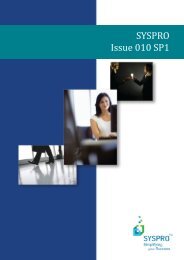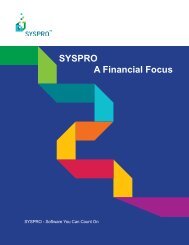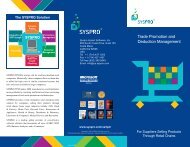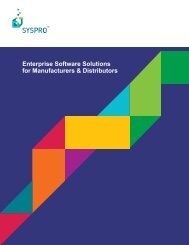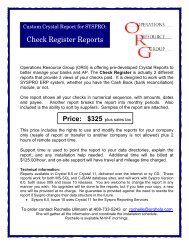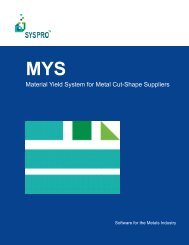Teach Yourself e.net - Syspro
Teach Yourself e.net - Syspro
Teach Yourself e.net - Syspro
You also want an ePaper? Increase the reach of your titles
YUMPU automatically turns print PDFs into web optimized ePapers that Google loves.
XmlParameters<br />
pass additional parameters to the business object.<br />
This is a well formed XML string providing<br />
parameters to the Post method.<br />
All the example code in this chapter assumes an operator code called<br />
"ADMIN" with no password and the use of company "1" with no password.<br />
When a method is invoked the return is provided by the business object specified. If the<br />
output of a business object is an XML instance, it will be "Well-Formed" and "Valid". The<br />
tree structure and element values contained in the returned XML will depend on the<br />
Business Logic embodied by the business object and the parameters passed within the<br />
input XML instances. Return information can then be used within the e.<strong>net</strong> solutions<br />
application. If an exception is raised, the return will contain the errors (see Section 9.1,<br />
“Error Handling” [9–1]).<br />
The application of XML within SYSPRO e.<strong>net</strong> solutions, combined with the generic<br />
nature of the class library, provides maximum flexibility in developing truly dynamic,<br />
scalable applications that preserve the integrity of data stored within SYSPRO. It also<br />
means that enhancements to existing e.<strong>net</strong> solutions applications are relatively easy to<br />
develop as the application is independent from the SYSPRO version or the specific<br />
implementation of SYSPRO within an organization.<br />
5.1. Utilities Class<br />
There are four Methods in the SYSPRO Utilities class structure: Logon, Logoff,<br />
GetLogonProfile, and Run. As their names suggest, they are used for logging on and<br />
off of the SYSPRO e.<strong>net</strong> solutions system, retrieving user settings and running custom<br />
written programs.<br />
5.1.1. Utilities.Logon<br />
Syntax:<br />
Utilities.Logon(Operator, OperatorPassword, CompanyId,<br />
CompanyPassword, LanguageCode, LogLevel, <strong>Syspro</strong>Instance, XmlIn)<br />
The Logon method enables authentication. If authentication is successful a unique<br />
UserID is returned. The UserID is a string that uniquely identifies an e.<strong>net</strong> solutions<br />
session. The UserID is therefore used to create a new session and authenticate the<br />
connection throughout the session and must be passed to all subsequent e.<strong>net</strong> solutions<br />
method calls for the duration of a session. To close a session use the Logoff method (see<br />
Section 5.1.2, “Utilities.Logoff” [5–6]).<br />
Business objects available to this method include:<br />
5–4



